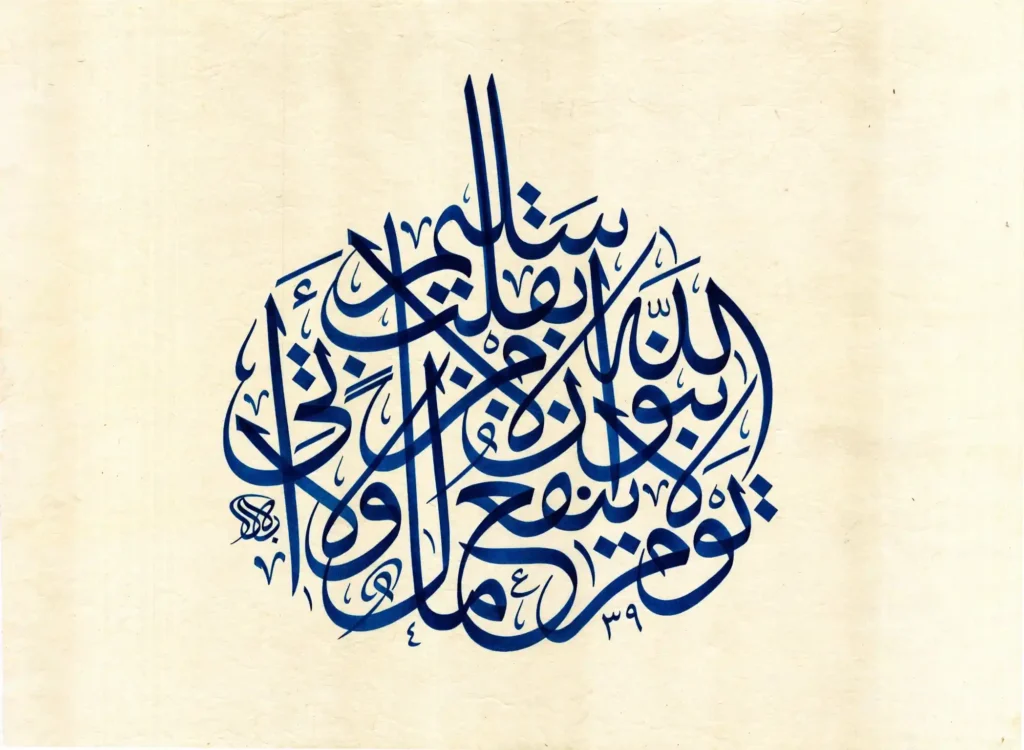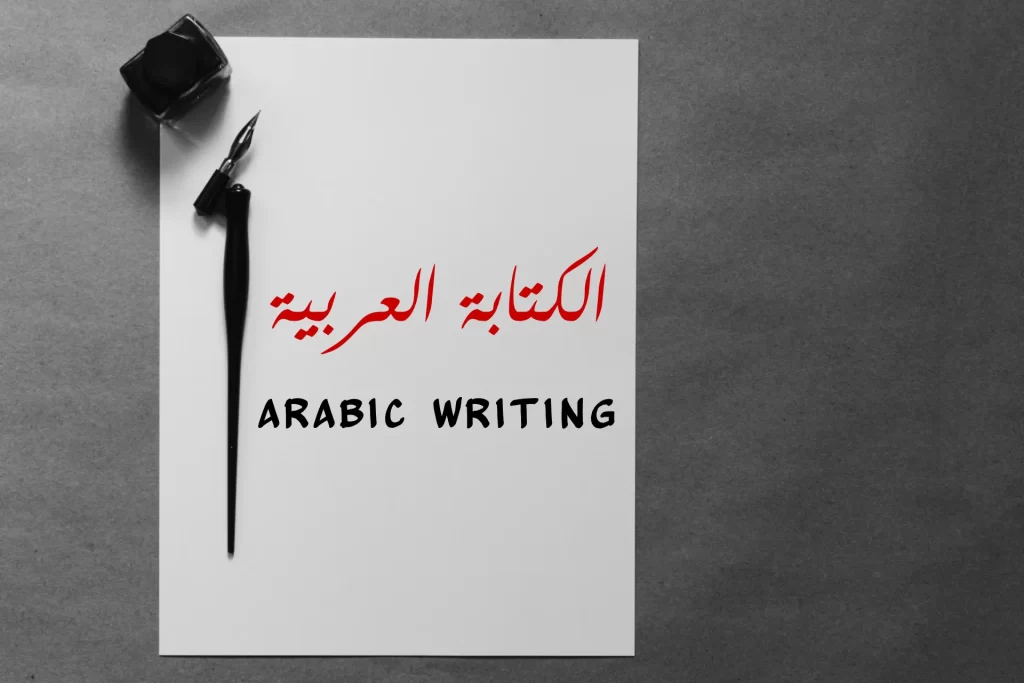As we all know, to learn any language you should be able to use its four skills (reading, writing, speaking, listening) and this is why we’ll try our best to explain the Arabic writing skill in this blogpost.
Arabic writing holds a rich cultural and historical significance, and learning to write in Arabic opens up a world of opportunities for communication, understanding, and appreciation. Whether you are interested in mastering the Arabic script or simply wish to gain basic proficiency, this post will guide you through the essentials of Arabic writing.
Let’s discuss everything you need to know to learn to write Arabic. We will cover everything from the basic Arabic letters and symbols to the tips and tricks you can do to learn Arabic writing easily.
Table of Contents
Why Learn Arabic Writing?
Arabic writing is much more than just a set of symbols and characters; it’s a gateway to a rich and diverse culture with a history spanning centuries. When you learn to write Arabic, you gain the ability to communicate effectively with over 400 million native speakers worldwide.
Whether you’re interested in exploring fascinating literature, understanding Islamic texts, exploring the beauty of Arabic Calligraphy, or simply connecting with Arabic-speaking communities, learning this skill will add a huge value to your language learning and proficiency.
Importance of Learning How to Read Arabic Alongside with Writing
Reading is an essential part of learning any language, including Arabic, so learning how to read Arabic goes hand-in-hand with writing it. Once you have grasped basic writing skills, practicing reading texts in Arabic will further enhance your proficiency. Start with simple texts such as children’s books or beginner-level articles and gradually work your way up.
Practice reading different texts aloud while paying attention to pronunciation rules that will greatly improve your language skills. Remember that consistent practice is the key. Learn more about enhancing your Arabic reading skill in this full article about “How to Read Arabic”.
Studying the Arabic Letters & the Arabic Script
To begin learning Arabic writing, it is essential to familiarize yourself with the Arabic script, which consists of 28 Arabic letters. These letters have unique shapes and positions within words and differ in their beginning, connecting and ending letterforms depending on placement within words, creating a beautiful and distinct writing system.
Therefore, it is crucial to learn the Arabic alphabet, known as “alif baa taa أ ب ت” which corresponds to the English alphabet A B C in Arabic. This foundation will serve as your starting point for mastering the art of Arabic writing. Head out to our full article about the Arabic Alphabet, its names, sounds, and how they are written.
Is Arabic Written Right to Left?
One of the most common questions we receive from our students is whether Arabic is written from left to right or right to left. The answer is the latter. Arabic is written from right to left, which can be challenging for those who are used to reading and writing in other languages. But, have no worries, as it’s a matter of time to adapt to this writing direction
After adapting to the direction of Arabic writing, most students will be familiar with the basic right to left orientation of Arabic script. However, it is equally important to understand the precise stroke sequence and formation method for writing each individual character in Arabic.
To get more adapted and familiar to the writing skill, regular homework assignments provide an opportunity to self-evaluate progress and identify any areas needing refinement. Mastering letter sequences is integral for developing an elegant, fluid handwriting motion.
Arabic Letter Connections and Flowing Forms
In contrast to English and many other languages, written Arabic contains connecting letters that smoothly join to one another. Mastering how letters combine into flowing word forms is crucial for developing an authentic handwriting style.
Therefore, you have to know how these letters are being connected to each other, and how their shapes change to create a word, which will give you a wider idea about how to write them in a correct and understandable way.
You will explore the various joining patterns between different letter types, such as alif Arabic combinations, endings that connect to alif, and more for this letter and the other letters. Through a series of worksheets, you also can practice connecting sample words and short phrases to cement your understanding of proper letter linking. Finally, with consistent application, this connectivity will become second nature.
Arabic Symbols or Diacritics
Understanding the symbols and their meanings is also an important aspect of Arabic writing. Each letter has its own individual sound when pronounced, enabling you to construct words and sentences effectively. Additionally, certain symbols such as diacritics (short marks above or below letters) can alter pronunciation or indicate specific grammatical rules.
| Symbol | Name | Pronunciation & Meaning |
|---|---|---|
| َ | fatḥah | a |
| ُ | ḍammah | u |
| ِ | kasrah | i |
| ً | tanwīn fatḥah | an |
| ٌ | tanwīn ḍammah | un |
| ٍ | tanwīn kasrah | in |
| ْ | sukūn | no vowel |
| ّ | shaddah | double letter |
| ~ | maddah | long vowel |
| ء | hamzah | glottal stop |
Developing a Personal Writing Style
Once confident with the basics of the writing skills, students can begin to shape and develop their own unique handwriting personality. Students can be inspired through examples of different Arabic typographies and calligraphic styles.
Also, optional creative writing prompts encourage self-expression while practicing letter forms. In addition, finding discussion topics help explore the cultural history and artistic traditions behind Arabic handwriting. With some individual flair, writing can become a means of creative self-expression in addition to communication.
Learning the Art of Arabic Calligraphy

Arabic writing is not just about mastering the letters and symbols, it is also about exploring the artistic history and calligraphic traditions behind Arabic script and creating beautiful and meaningful calligraphy. Through Arabic calligraphy, you will learn to write in Arabic script and understand the meanings behind each symbol. This will not only enhance your writing skills, but also give you a deeper appreciation for the intricacy of the Arabic language. Head out to our full article about Arabic Calligraphy.
Talking about Arabic Calligraphy, you should know that it plays an important role in Islamic architecture, with ornate Quranic verses commonly featured in prominent displays. Different regions also developed unique styles that evolved from the original Kufic script. Also, beyond mere transcription, master calligraphers composed flowing works of visual expression through ink and reed pens. Take a look at these artworks by our master calligrapher, Belal Mokhtar to see how Arabic calligraphy is really a piece of language art.
We encourage students to contemplate how the written form reflects and has shaped Arab identity and arts. Learning penmanship entwines function and aesthetic in a holistic linguistic experience.
Arabic Practice Writing
As the saying goes, practice makes perfect. To truly grasp Arabic writing, practice is key. Regularly engaging with reading materials such as books or online resources will help improve your skills over time. Additionally, seeking guidance from language instructors or joining language exchange programs can provide valuable support on your journey towards mastering written Arabic.
Mastering Written Communication Skills
With strong command of the written system and vocabulary, learners gain the tools to engage more deeply with Arabic texts, signage and media. Beyond foundational literacy, developing fluent handwriting further equips students for real-world communication contexts. For instance, professionals may need to draft business documents, take meeting notes or fill out Arabic forms in their field of work. Students can also apply penmanship for personal correspondence, keeping a journal in Arabic, or making shopping lists during travels. Our curriculum aims to produce well-rounded competence empowering productive use of written Arabic in diverse situations.
Conclusion
As a language that is rich in culture and history, learning Arabic writing is not just about mastering the characters, but also about immersing yourself in the beauty of the language. The skills developed through dedicated study of Arabic handwriting, such as technical precision, creative expression, and global cultural exchange, provide lifelong benefits.
We hope that you have now all the answers to the questions on your mind according to learning Arabic writing skill which will definitely add a huge value coming with fun to your learning journey and to your language skills overall.

